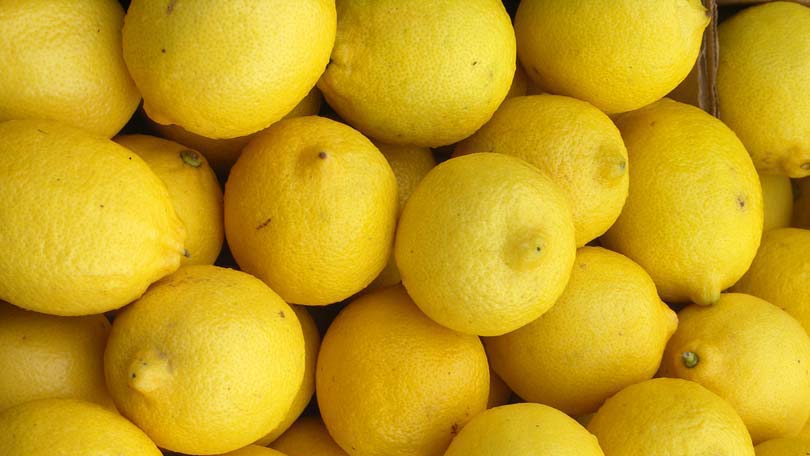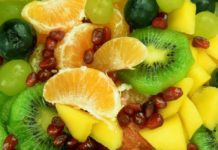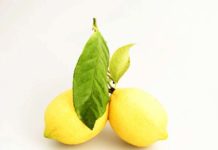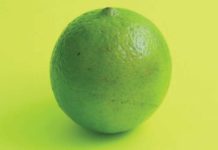
With their myriad uses in food and drink recipes, lemons are an indispensable kitchen staple. It might come as no surprise that this fruit has been valued for its fragrance, flavor, and chemical properties for eons in cultures around the globe.
The lemon is a cultivated hybrid, and its predecessor – the citron – appears to be the first identified citrus fruit. Evidence of the lemon has been found in the ruins of Pompeii, which was buried when Mount Vesuvius erupted nearly 2,000 years ago. Official records of lemon cultivation can be traced back to the mid-1400s in Genoa and the Portugese Azores. It is generally accepted that lemons were first cultivated in India.
Lemons favor tropical and sub-tropical climates. They are grown in many Mediterranean and South American countries, although California is the top global commercial producer, providing nearly one-third of the world’s lemons.
The lemon’s juice, pith (the white layer between pulp and skin), and zest (the yellow rind) are used widely in recipes for both food and drink.
When shopping for lemons, look for a heavy, compact fruit with a bright yellow hue. They should be firm, but not hard. Their skin should be glossy and fine-pored. You’ll find them year round, but their peak season is April through July.
Lemons will keep for up to two weeks at room temperature. You can extend their lifespan by refrigerating them in a zip-loc baggie for up to six weeks.
Fresh lemon juice is preferable to bottled. You can squeeze lemon juice into ice cube trays, then transfer the frozen juice to zip-loc baggies.
There are many gadgets available to remove the juice from lemons. One is a reamer, which is a ridged cone that filters the juice through to a bowl you set beneath it. Another is a hinged juicer, which squeezes one half through slots and catches any seeds. You can also express the juice by holding the half upright in your hand so that the seeds go into your hand instead of the bowl. (You will get the most juice from a lemon that is at room temperature. Also, rolling it about prior to juicing will break down the pulp and release more juice.)
The chemical properties of the lemon – specifically, its characteristic citric acid – provide many valuable uses in the kitchen and in medicine.
One of its most common chemical uses is to prevent browning of fresh-cut fruit. Because their acid slows oxidation in fresh-cut fruits and vegetables, lemons serve as a valuable preservative. Sprinkle lemon juice on apples, peaches, or other fruits that are likely to show the signs of oxidation immediately after slicing so that they will not brown.
The citric acid found in lemons also neutralizes the amines found in fish, so their juice is often sprinkled atop seafood dishes. Similarly, this citric acid hydrolyzes meat’s collogen fibers, making it an ideal ingredient in marindades to tenderize beef, chicken, and other meats.
On the medicinal front, lemons provide a large amount of vitamin C. (There are aboiut 50 milligrams of vitamin C and 5 grams of citric acid to every 100 milliliters of lemon juice.)
This high vitamin C content prompted the British Royal navy to use them to prevent svurvy. Also, many practitioners of Ayurvedic medicine believe that lemon juice in hot water detoxifies the liver. This belief has spread to western culture, and is an often employed step in dietary detoxes.
Here is an especially pretty recipe with its dusting of powdered sugar atop a rich lemon custard and buttery cookie crust.
Lemon Bars
For cookie crust:
1/3 cup butter
¼ cup granulated sugar
1 cup all-purpose flour
For filling:
2 eggs
¾ cup granulated sugar
2 tablespoons all-purpose flour
2 teaspoons finely shredded lemon peel
3 tablespoons lemon juice
¼ teaspoon baking powder
For topping:
¼ cup confectioner’s sugar
Beat butter for 30 seconds.
Add ¼ cup granulated sugar and beat until thoroughly incorporated.
Add 1 cup flour and mix until it forms a crumb dough.
Pat crumb mixture into bottom of an 8” square cake pan.
Bake at 350 degrees for 15 minutes or until top is lightly golden.
While the crust is baking, make the filling as follows:
Combine eggs, ¾ cup granulated sugar, 2 tablespoons flour, lemon peel, lemon juice, and baking powder. Beat 2 minutes until thoroughly combined.
Pour filling over baked crumb crust.
Bake 20 minutes at 350 degrees. When done, the center will be set and the edges will be lightly golden brown.
Cool on wire rack.
Sift confectioner’s sugar evenly on top.
Cut into bars.





